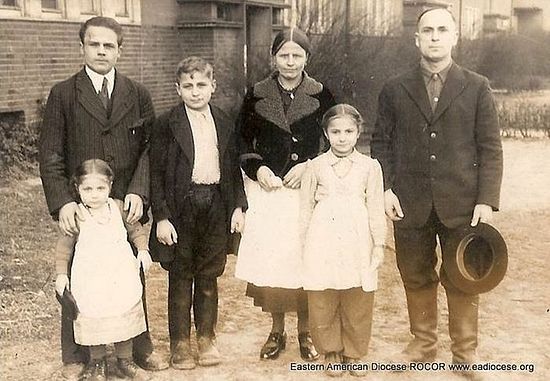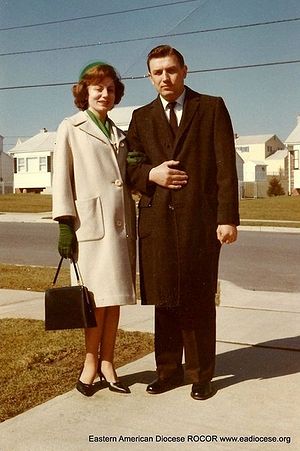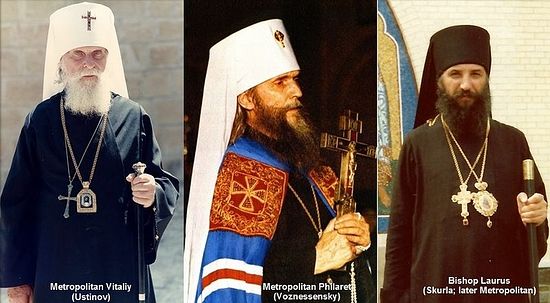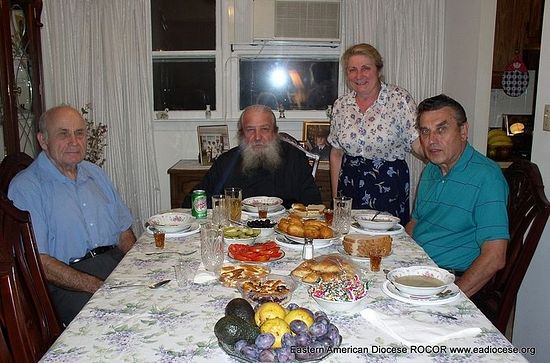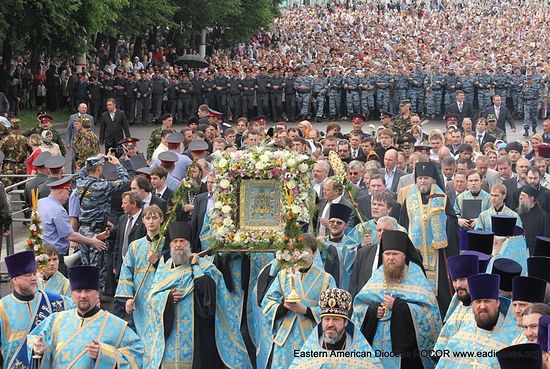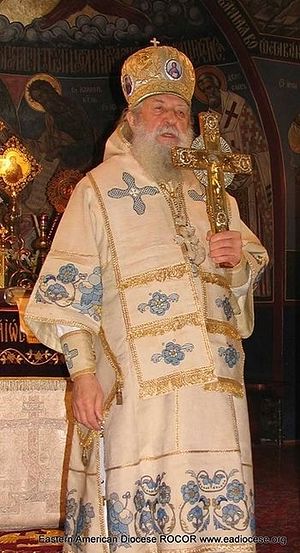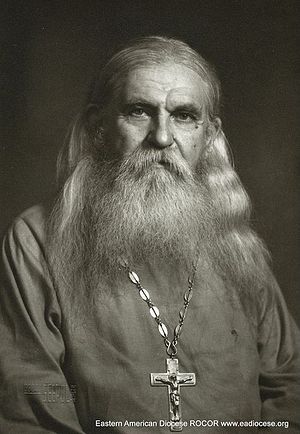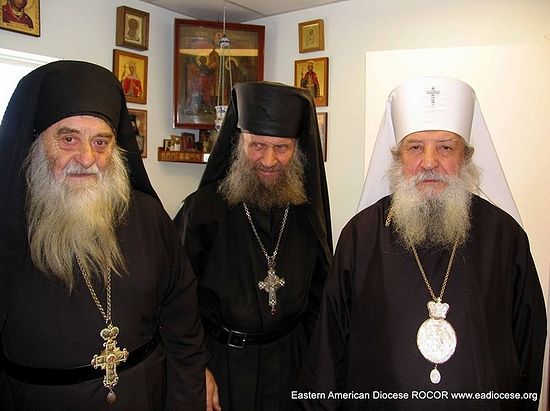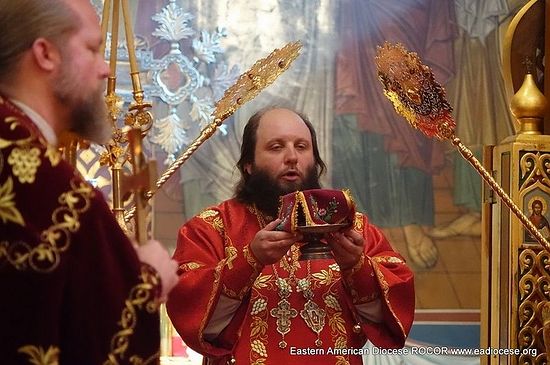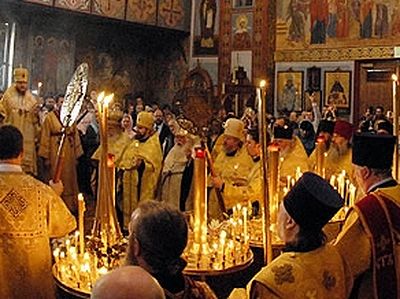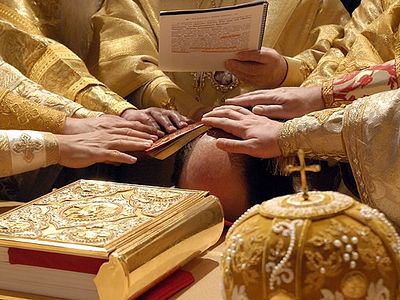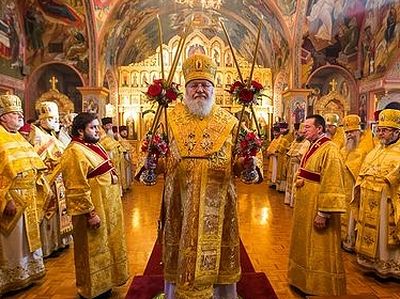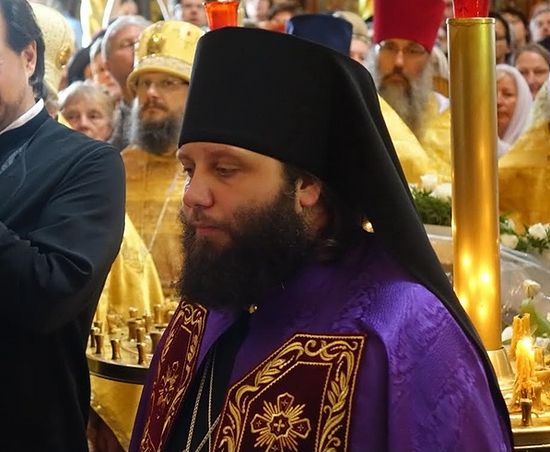
"Right here is where I carry out my spiritual labors," ‒ says Father Nicholas. In the Synodal Headquarters of the Russian Church Abroad in New York City, we walk past the guestrooms, each with a plaque showing the name of the Hierarch to whom the room belongs. "Metropolitan Hilarion stayed here when he arrived from Australia, before his election as First Hierarch. Next door is the room of Archbishop Kyrill of San Francisco and Western America, Secretary of the Synod of Bishops, and beyond that, the meeting room of the Council of Bishops and the Synod of the Russian Orthodox Church Outside of Russia."
Later, I discovered that in the same room where Fr. Nicholas carries out his spiritual labors (this is how Archimandrite Nicholas put it, instead of using the word "live"), lived other clerics, incuding his predecessor, Archpriest Boris Kritsky, guardian of the Kursk Root Icon of the Mother of God. Through the windows, one can see the gold cross atop the Cathedral of the Sign. A desk with a computer, a fireplace and bookshelf, a bed, many packets with the akathist to the Kursk Root Icon, portraits and photographs adorning the walls… On the fireplace sit icons of the Savior and Most Pure Theotokos, St. John the Baptist, St. Eudoxia, St. Elizabeth the Wonderworker of Constantinople, and a portrait painted during the lifetime of St. Nicholas of Japan. On Friday, April 4, on the eve of the Laudation of the Most Holy Theotokos, Fr. Nicholas was tonsured a monk, and retained his former name of Nicholas, but simultaneously gained a new Heavenly intercessor – the missionary and enlightener of the Land of the Rising Sun – St. Nicholas of Japan.
An open space in the center of the room is occupied by a copy of the Kursk Root Icon of the Mother of God, a gift from Archbishop (now Metropolitan – ed.) Herman of Kursk & Rylsk. It is usually here – between her travels to dioceses, monasteries, and parishes – that the wonderworking Kursk Root Icon is kept. After Pascha, on Bright Thursday, the Icon departed for Europe, to the Diocese of Germany, and at the end of June arrived in California, where she graced the celebrations in honor of the 20th anniversary of the glorification by the Church Abroad of the Holy Hierarch and Wonderworker John of Shanghai & San Francisco, the work of the Council of Bishops, and the All-Diasporan Youth Conference.
During the celebrations in San Francisco, on Sunday, June 29, Archimandrite Nicholas (Olhovsky) was elevated to Bishop of Manhattan, vicar of the Eastern American Diocese. In the middle of August, the Kursk Root Icon will return to New York, to her home, and will reside with Bishop Nicholas in a new room.
Our roots are in Belarus. During the Second World War, my parents were able to evacuate with their families through Poland to Germany and from there, in 1948, to Brazil. Initially, they lived in Rio de Janeiro, and then moved to São Paulo, where they attended the Russian cathedral named in honor of St. Nicholas the Wonderworker. From August 1951 until his transfer to Western Canada by the Synod of Bishops, the cathedral’s rector was Bishop Vitaly (Ustinov), future fourth First Hierarch of the Russian Church Abroad.
In 1961, the Olhovskys (my father’s family) and the Rusinoviches (my mother’s family) immigrated to the United States. In America, they found freedom, work, reconnected with Russian acquaintances; Russian Orthodox churches were built, and they were not forced to betray or hide their Faith as they would in the Soviet Union. When my parents came to America, my father was 19, and my mother a few years younger. They had known one another back in Brazil, and in 1966, they married in America – in the Protection of the Mother of God Church in Rochester, NY.
My parents began their family life in New Jersey, and my brothers – Paul and Serge ‒ and I were all born in the state capital, Trenton. At that time, there were many Russians living in the suburbs, and in Trenton, the émigrés founded a church dedicated to the Dormition of the Most Holy Theotokos. I was born in December 1974, and on the eve of the Lord’s Theophany – in 1975 – I was baptized in that church. This was an exciting time in New Jersey, as many churches were established, in Jackson, on St. Vladimir’s Mount, and very close to there in Lakewood, St. Alexander Nevsky Church. In the 1990s, they built a new church in Lakewood, a cathedral dedicated to the Holy Right-Believing Grand Prince Alexander Nevsky, while the little church was renamed in honor of the Tikhvin Icon of the Mother of God.
What did your parents do for a living? What was your family life like?
My father was a hard worker and engineer. My mother raised us, and spent her time caring for the home. We tried to have the whole family at dinner in the evenings. We all spoke only Russian at home; we prayed in the morning and evening. I remember how my mother would get on her knees with us and we would read the prayer to the Guardian Angel, and on Saturday evenings, Sundays, and feast days we would attend all of the services. We were parishioners of Holy Dormition parish in Trenton. My parents, like others in the parish, worked tirelessly for the benefit of our humble, prayer-filled church. But our little parish did not always have weekday services, and in those instances we would travel to St. Alexander Nevsky Church in Lakewood, or to St. Vladimir Memorial Church. My brothers and I attended the Lakewood parish school, where Russian students would gather on Saturdays from all around ‒ Princeton, Jackson, Trenton, even from Philadelphia. In school, they taught us the Law of God, Russian, Russian Literature, History, and singing and dancing. Our spiritual father was the rector of St. Alexander Nevsky Church, Archpriest (now Protopresbyter) Valery Lukianov, and the principal of the Russian school was Michael A. Lermontov, a relative of the great poet Mikhail Yuryevich Lermontov. Michael Alexandrovich ‒ our "Uncle Misha" ‒ spent all of his free time with us, the children. After classes were over in the Russian school, he would give us lessons in drawing in his workshop in the basement of the "Rodina" Society hall. He taught us how to make greeting cards for Nativity and Pascha, and how to paint Pascha eggs.
But from Monday through Friday, we had another life: like all children, we attended American school with our American friends. There was no awkwardness on account of our being Russian. Although, when we were little, my brothers and I would be a little sad that all of our American friends were celebrating Christmas on December 25. They had vacation, a Christmas tree, presents, while we had a break from classes and… the fast. Everyone came back from vacation in new clothes, talking about their holiday, while our feast day was still a week off. But when we grew up, we started taking pride in the fact that our feast was still to come, and explained our Orthodox Faith and the calendar to our friends. And it was a thing of interest to them.
What are your most vivid childhood memories?
From among the clergy, I remember Metropolitan Philaret (Voznesensky), Metropolitan Vitaly (Ustinov), a young Metropolitan Laurus, Archimandrites Cyprian (Pyzhov) the iconographer, Vladimir (Sukhobok), and Sergius (Romberg); Abbot Gurius (Golosov), Archpriest Boris Kritsky, and other priests. I remember my grandmothers: my father’s mother, Ekaterina Sisoevna, and my mother’s, Irina Eliseevna. My grandfather, Nicholas A. Olhovsky, died in Hanover, Germany in 1946. My mother’s father, Gregory A. Rusinovich, died in 1966.
I was 5-6 years old when I was first acquainted with the monastery in Jordanville and the monastic brethren. Our whole family would travel there for Pentecost, for Labor Day, and other holidays. I remember that the monks I met in my youth were not serious or morose, but joyful and hardworking; they would converse with us, ask us about our lives, and when we came to the monastery in the summers without our parents, they would take us under their wing. We would serve in the altar at the monastery, and it was interesting for us to be near people who had dedicated their lives to God.
In the year of the Millennium Celebrations of the Baptism of Rus’, I traveled alone to the monastery for the first time, as a "summer boy." I was almost 13 years old. The daily early morning services had a particular impact on me. The monks would begin at five o’clock with Midnight Office, and you had to be in church by six o’clock for Liturgy. You would step out into the morning fog amid the peal of bells. It was very lovely. Later, there would be breakfast with the brethren and various obediences: some worked in the cowshed, some in the garden, others helped maintain the cemetery or worked in the book warehouse or the kitchen. I considered myself fortunate when Archimandrite Cyprian, the iconographer, allowed me to spend my time in the iconography workshop and let me help him as he painted icons, though he would say in a strict voice: "Do exactly as I tell you." It was a particular joy for us to interact with the monks and with other Russian boys, who traveled to Jordanville from all over.
Was that when you decided to go and study at seminary?
I decided for sure at age 16. I always loved God’s church and wanted to serve the Church, emulating our preceptors. Having graduated high school in 1993, at the end of August I moved to the monastery and settled in the seminary dormitory.
And that is when you began to interact more closely with Archbishop Laurus?
Archbishop Laurus and I got to know one another when I was still a child. He often visited us in New Jersey and our neighboring parishes for their patronal feast days. My godmother ‒ Alexandra S. Romanovsky, and her husband Nicholas were very close to the monastery, traveling there often and spending the summer. When His Eminence would come, he would unfailingly stay with them, sometimes along with someone from the brotherhood, and my godmother, who spiritually adopted me, would absolutely invite our family over. Our clergy and our Hierarchs were always very accesisible, and we always had an opportunity not only to observe them at the divine services, but also to talk with them in person.
My interaction with Metropolitan Laurus (by that time he was already Archbishop of Syracuse & Holy Trinity, monastery abbot and seminary rector) continued at seminary. I fulfilled my obedience on the kliros, in the icon-mounting studio, in the bookbindery and, beginning in 1994, in the typographical studio, where I worked for eight years. I continued working in the typographical studio even after my graduation, and began helping Archbishop Laurus on his travels throughout the Diocese and with his various administrative duties.
The dean of students (inspector) of the seminary at that time was Archimandrite Peter (Loukianoff), now Bishop of Cleveland. In 2000, he was appointed Head of the Ecclesiastical Mission in Jerusalem. I remember Fr. Peter calling for me and handing me the keys to the abbot’s office, as Archbishop Laurus gave me his blessing and said, "God bless you for your labors."
When did you first become acquainted with Russia in person?
In 2001, a small group – six of us – participated in a pilgrimage to Russia. Archbishop Laurus flew in two days before the rest of the group. We met in Moscow and departed for the Solovetsky Islands. We traveled by car from Moscow to Petrozavodsk, and then by boat to the Solovki Monastery. There we ordered a tour and stayed for four days. At that time, they had only begun restoring the monastery.
Did anyone know that you were coming? Did the administration on Solovki know?
No. Archbishop Laurus visited the holy sites incognito, wearing only a cassock and cross. We came as simple pilgrims, visited Sekir Mountain and Anzer Island, and venerated the relics.
We prayed, viewed the holy places, and quietly departed. Later, we visited Novgorod, St. Petersburg, and Moscow. It left a colossal impression on me. Ever since we were children, they told us that we are Russian, but when you see Moscow and the other cities in person, only then can you appreciate the depth of the spirituality of the Russian people. That is when you realize – yes, I am Russian. And years of history pass in front of your eyes: Russian refugees flee Russia, and see how many Orthodox churches are erected across the world as a result of their departure. What spiritual strength! That means it was Divine Providence. And with the unification of the Russian Church, it has grown all the stronger. By the way, Metropolitan Laurus did not like the word "unification," since the Church was always one. He would correct people and say that it was a reconciliation.
Metropolitan Laurus was elected First Hierarch at the Council of Bishops that same year, in October 2001…
He accepted this as an obedience; everything that he had to do over the course of his life, he did for the sake of obedience, however he did not want to leave the monastery. And the Council of Bishops blessed Metropolitan Laurus to remain at the monastery and continue fulfilling the duties of abbot.
How did His Eminence make it possible for the Kursk Root Icon to return to Russia?
After the signing of the Act of Canonical Communion in May 2007, a meeting was held with Metropolitan Herman and a delegation from Kursk. They visited with Metropolitan Laurus and suggested a visit by the Kursk Root Icon to the city of Kursk. The wonderworking Icon has been located in America since 1951, but her mission is to travel the whole world, wherever there are Russian people. The proposal was put to the Synod of Bishops who agreed if, the main cathedral in the Kursk Root Hermitage, dedicated to the Nativity of the Most Holy Thetotokos was restored. Metropolitan Laurus said that the restoration of the cathedral would make a visit by the Icon possible.
But he did not live to see the return of the Icon to Kursk…
The first visit of the Icon to Russia took place in September 2009. First the Icon arrived in Moscow, and traveled from there to Kursk, to the Cathedral of the Sign. A light rain left a rainbow hanging over the cathedral. Half a million people came out to greet the Icon; practically all of Kursk was closed down. Later, the Icon was taken to the Kursk Root Hermitage, and the following day they consecrated the Cathedral of the Nativity of the Most Holy Theotokos. Metropolitan Hilarion fulfilled the promise of his ever-memorable predecessor, and now, with the blessing of His Holiness, Patriarch Kyrill, the Icon visits Kursk and other cities in Russia.
But Metropolitan Laurus’ final visit to Russia was in February 2008, when Moscow Mayor Yury Luzhkov presented him the "Compatriot of the Year" Award. It was very cold in Moscow, and when we returned to the monastery, not long before Great Lent, it seemed that His Eminence had caught a slight cold. Nevertheless, he did not miss the services for the first week [of Lent – trans.].
On Friday of the first week of Lent, we served the Liturgy of the Presanctified Gifts. When I came that morning, Metropolitan Laurus was already in church. We served Matins, Hours, and began to serve the Hierarchal Rite Liturgy. It seemed that all was well, but at the end of the service, it was obvious that His Eminence had a very bad cold. He went to the refectory with the brethren, and later to his office. On Saturday night, the eve of the Triumph of Orthodoxy, I called the Metropolitan in his "skete," as he called his residence at the monastery. He said that he was feeling a little better, but added: "Call tomorrow morning and check in."
The following morning, on Sunday, the Triumph of Orthodoxy, when Archimandrite George (Schaefer), now Bishop of Mayfield, and I drove up to the skete, we saw Protodeacon Victor Lochmatow. He had brought Metropolitan Laurus food; he knocked, but there was no answer. We immediately realized that something was wrong. When we went into his room, we saw that he was lying peacefully… Fr. Victor began to weep, as Fr. George and I stood there in shock.
They rang the large monastery bell 12 times. The brethren came, served the canon for the departure of the soul, and began to read the Psalter. They brought His Eminence in procession to the monastery cathedral, where they began the rite of vesting.
We vested His Eminence in a plain gold and white set of vestments which he had previously shown to me while preparing for a routine trip. He also showed me a panagia with an icon of Christ’s Resurrection, which had been given to him by Metropolitan Philaret.
The monastery choir sang during the vesting, while the brethren, seminarians, and parishioners prayed. When I returned to the skete that evening to clean and lock up, I remembered what His Eminence had told me the day before: Call in the morning and check in. Thank you for your care." Those were his last words. Metropolitan Laurus kept a journal. The journal lay open on the desk and I read it: "I did not go out today. It is peaceful today,foggy. I felt better toward evening. I did not go to the services, but read evening prayers in my room. Lord, bless these days, that I might recover and resume once more my duties at the monastery." And further: "March 16. Sunday. Triumph of Orthodoxy."
Metropolitan Laurus was buried under the altar of Holy Triniy Cathedral.
Soon you lost another person dear to you ‒ your wife Elisabeth reposed… You likely found comfort only with your appointment as guardian of the wonderworking Kursk Root Icon. Where was the Icon before this? How did she travel?
The first guardian of the Icon can be considered to be Bishop Theophan (Gavrilov) of Kursk, who took the Icon out of Russia and brought her to Greece through Turkey; later, after a short visit to the homeland, she went to Serbia. During the War, Metropolitan Anastassy (Gribanovsky) brought the Icon to Germany through Austria. In Munich, the guardian of the Icon was Archimandrite Averky (Taushev), later Archbishop of Syracuse & Holy Trinity. He would visit our parishioners, refugees, with the Icon, and in 1951 came with her to New York State. In time, Archpriest Boris Kritsky was appointed the Icon’s guardian; he was a widowed priest, formerly subdeacon to Metropolitan Anthony (Khrapovitsky). He traveled with the Icon, and after his repose in 1989, then-First Hierarch of the Russian Church Abroad Metropolitan Vitaly (Ustinov) assumed guardianship and would appoint various priests to travel with her.
I was widowed in September 2010, and in December of the same year the Synod of Bishops bestowed upon me the obedience of accompanying the Kursk Root Icon. For me, this was an untold joy. The following year, the Icon traveled to the Metropolitan District of Kazakhstan, and to Kursk.
In 2012, I was ordained to the priesthood. At that time, my spiritual father from childhood, Protopresbyter Valery Lukianov, offered me this counsel: "You mustn’t know the word ‘No.’ Know only humility and sacrifice." Now I have received new orders…
What was your reaction upon learning of your coming appointment?
We had just returned from a trip with the wonderworkering Icon to Japan and Russia’s Maritime Province (Primorsky Krai), and with each year, my obedience was bringing me greater spiritual joy. The previous year (2013) was a very busy one for me: during Great Lent, the Icon visited California; during the summer, the youth camps in New York State; in the autumn, Voronezh, Belgorod, and Kursk. And I grew all the more certain that the Icon’s mission began when Bishop Theophan took her out of Russia: around the world, wherever I would travel with the Icon, I saw wonderful Russian Orthodox churches, built by the labors of refugees. I will never cease to be amazed at the love and triumph with which the people greeted their Protectress and Guide (Hodegetria).
Last year, as usual, the December session of the Synod of Bishops was planned around December 10, the feast day of the Kursk Root Icon of the Mother of God. Upon completion of the festal Liturgy, Metropolitan Hilarion invited us ‒ Hierarchs and clergy ‒ to his chambers, to the main reception room. At some point, he asked only the Hierarchs ‒ and me ‒ to remain. And then I heard that my candidacy had been proposed for the vacated Manhattan vicariate. At that moment I prayed, not knowing what to say, other than: "I thank you, I accept, and I say nothing against it." I thanked their Graces and Eminences, asked their prayers, and returned with the Icon to my room, where I served a short moleben and litiya, commemorating all of my friends and teachers, praying for the health of the living and the repose of the dead.
Were you expecting them to change your name at tonsure?
I prepared in advance for my tonsure. A cowl (klobuk) and mantle were being sewn for me in Gethsemane, a fact especially precious to me, while a second cowl and mantle were being sewn in Jordanville. Of course, as a human being, I was somewhat nervous: what would happen to my name? After all, I was very attached to my Heavenly patron, the Holy Hierarch and Wonderworker Nicholas! I was born on December 17, "on St. Barbara’s," and our parish priest Fr. Anatolii Trepachko recommended baptizing me with the name Nicholas, in honor of the saint whose memory was celebrated two days after St. Barbara. And, for my whole life, I celebrated my birthday and namesday together.
On the day of my tonsure, I already knew that the Saturday on which the Laudation of the Most Holy Theotokos was to be celebrated was the feast day of Venerable Nikon of the Caves, and of the Monk-Martyr Nikon. It’s settled, I thought: I will be Nikon. We celebratedthe festal Matins and Akathist. My father, brothers, and the parishioners from the Cathedral of the Sign in New York City, from Boston and elsewhere all came for the tonsure. It took place after the First Hour. The moment of my appellation was at hand. The abbot of Holy Trinity Monastery in Jordanville, Archimandrite Luke (Murianka), proclaimed: "Our brother Nicholas is tonsured…" And so, at the dismissal, Fr. Luke spoke the name of the Holy Hierarch Nicholas of Japan.
Of course, I was overjoyed. We had recently traveled to Japan with the Icon, served in Tokyo’s Nikolai-do Cathedral, and visited the burial place of St. Nicholas. I am joyful that the Lord blessed me with the name of this saint, who sowed the seeds of the Orthodox Faith in Japan.
I spent three days in the cathedral and served for a week in the monastery, returning on Great Monday evening to the Synod of Bishops in New York City, where I spent Passion Week. My experience as a monk has not been a lengthy one, but even now I understand how important it is for a Hierarch to feel the support of the monastery brethren, how important it is for him to be with the brethren himself. I may be far from a good example of monastic asceticism, but with God’s help, I will be happy to try to follow namely this path in my coming service.
Recently the issue has been raised in the press, and beyond, regarding whether elevation to the Episcopate relieves, in a way, part of a monk’s monastic vows…
As far as I am concerned, as I noted, I will attempt to fulfill my monastic vows. Metropolitan Laurus was a father to all of the seminarians and monks at the monastery, an example of monasticism, an example of church order. As an archbishop, and even after his election as First Hierarch, he continued to live in the monastery in a little house in the skete. He did not miss the monastery’s divine services; he rose at 4:30 in the morning, at 5 o’clock proceeded to the monastery for Midnight Office, followed by Liturgy, lunch, and administrative work.
Metropolitan Laurus gave this orderly life to us, as well. In our seminary, the seminarians wear cassocks. His Eminence would say that, during his studies, a seminarian must already begin providing a good example, especially to the laity: he must be responsive and humble. He did not pressure us or force us; he lived like this himself. And with time, I realized why everything worked out for him. But, though a humble monk, he was also, at the same time, a Bishop, and served with the triumph and majesty befitting a Hierarch in the traditional practice of the Russian Church.
Archimandrite Luke, the abbot of Holy Trinity Monastery, tonsured me into monasticism, and said these parting words: "You face a new obedience. Serve God and the Church, but know the word ‘humility.’ When you take off your panagia and vestments, what remains? Your cassock, belt, and paraman. You are first and foremost a monk. Never forget this."
In my heart, I had thought of monasticism, but it took place earlier than I had intended. And I understand that this is the will of God.
Your Grace, last winter we learned that your candidacy for the post of Bishop of Manhattan had been approved. You began more frequently visiting parishes, and you traveled frequently with the Icon over the last three years, as well. What have you seen in the parishes that concerns you most?
Above all, I have noticed that the people of God do not understand or feel the service, do not comprehend the beauty of the divine services. And the liturgical cycle is so significant and so lovely! Everything takes part in the Orthodox service: the mind is focused on understanding the service and prayers; the ears, on the readings and hymns; the nose, on the scent of the incense and wax candles; even the color of the vestments has meaning, and I would like for the people to see and understand this.
On Bright Week, I accompanied the Kursk Icon to Germany. Nuns from the convent in Buchendorf greeted me in the airport, and we traveled to the Greek church, where Archbishop Mark was serving that day. We arrived at the church during the singing of the Creed. In order not to interrupt the Liturgy, I quietly entered and placed the Icon on an analogion, and stood myself off to the side. At this important moment in the service, the people began coming to the Icon, and instead of prayer, the result was some kind of rotating commotion. Or note: it was Bright Week, and the people were making prostrations. People do not understand, do not comprehend the divine services. Few of the faithful attend the evening services on Saturday. But therein lies the entire meaning of the feast!
As a young man, how did you imagine your life would be?
I always desired to serve in church or in a monastery, but I had no idea where or how. Most important for me was to help people and pass along what I had received from others. Simply put, I always relied on the will of God. And the Lord led me.
Your Grace, what qualities do you treasure in people?
Sincerity, kindness, openness and, of course, faith in God. You can be educated, modern, hospitable, knowledgeable about various cultures and languages, but when a person believes in God, this is a powerful unifying force. I like people who know how to be joyful and spread their joy to others. As the Apostle Paul says, "Rejoice evermore. Pray without ceasing.In every thing give thanks" (I Thess. 5:16-18).
What qualities do you find unpleasant in people?
An internal distance between a person and God. I pity such a person; he does not understand what he is missing. Computers, games, and cell phones cannot replace prayerful interaction with the departed or personal interaction with the living, with friends; they cannot replace contact with nature. These people are robbing themselves of the depth of perceiving the world, of understanding life, and of their nation’s history, even their family.
What places would you like to visit?

I have been spoiled with many travels. But such places still exist. Metropolitan Laurus and I visited Pochaev Lavra. I would like to return there. I have never been to Optina Hermitage. I would like to travel there, as well as to Holy Trinity-St. Sergius Lavra, to St. Alexander Nevsky Lavra in St. Petersburg. I would like to pray with the brethren of the monastery. I would like to take my time and visit the holy places of Russia. I have a desire to visit China: Shanghai, Harbin, wherever there was a Russian colony.
What books do you read?
The Gospel, the Lives of the Saints for every day, the works of Dostoevsky, Lermontov, and other writers. Every day, I try to follow the news.
Let us now descend from the exalted to everyday life. What food to you like?
According to the tradition of Holy Trinity Monastery, where I was tonsured, monastics refrain from meat. For this reason, I give preference to salads, fruits, potatoes, and mushrooms. I do not like spicy food, and cannot eat herring or onions. I like and know how to prepare meals myself. That is how we were raised.
Your Grace, you preserved your name Nicholas in monasticism. Considering how worried you were (as is everyone, who approaches tonsure), this became a great joy and comfort for you. What other joys have warmed your heart as of late?
I am overjoyed by the trust placed in me by the Church Hierarchy, as well as the closer interaction with the clergy that lies before me, and with the people who have been entrusted to me, thanks to my new obedience of Archpastoral service in New York. In the Cathedral of the Sign at the Synod of Bishops in New York City, I have already had a chance to grow close to the clergy, who toil diligently, along with the warden and his assistants, the sisterhood and choir, all caring for the adornment of the church and creating a warm and prayerful atmosphere for the good parishioners and worshipers.
There is also this joy: the abbot of Holy Trinity Monastery, Archimandrite Luke, offered to let me stay in Metropolitan Laurus’ skete whenever I visit Jordanville. It is a true joy for me to be in the home of my spiritual father and teacher. I never had the goal of becoming a Bishop, or even a priest; I never had a goal to live in that house. I simply take what is given to me, and I give thanks to the Lord.
